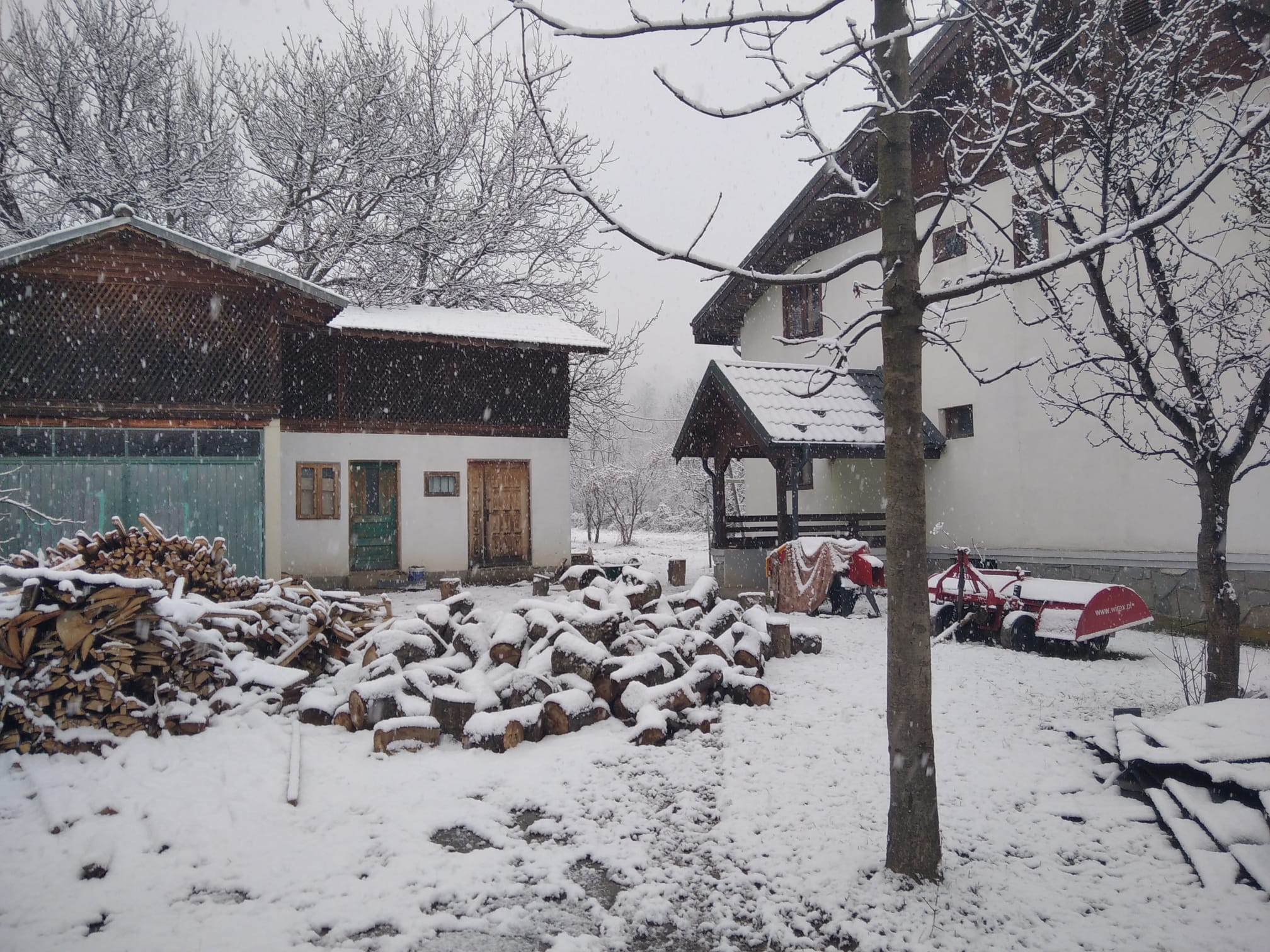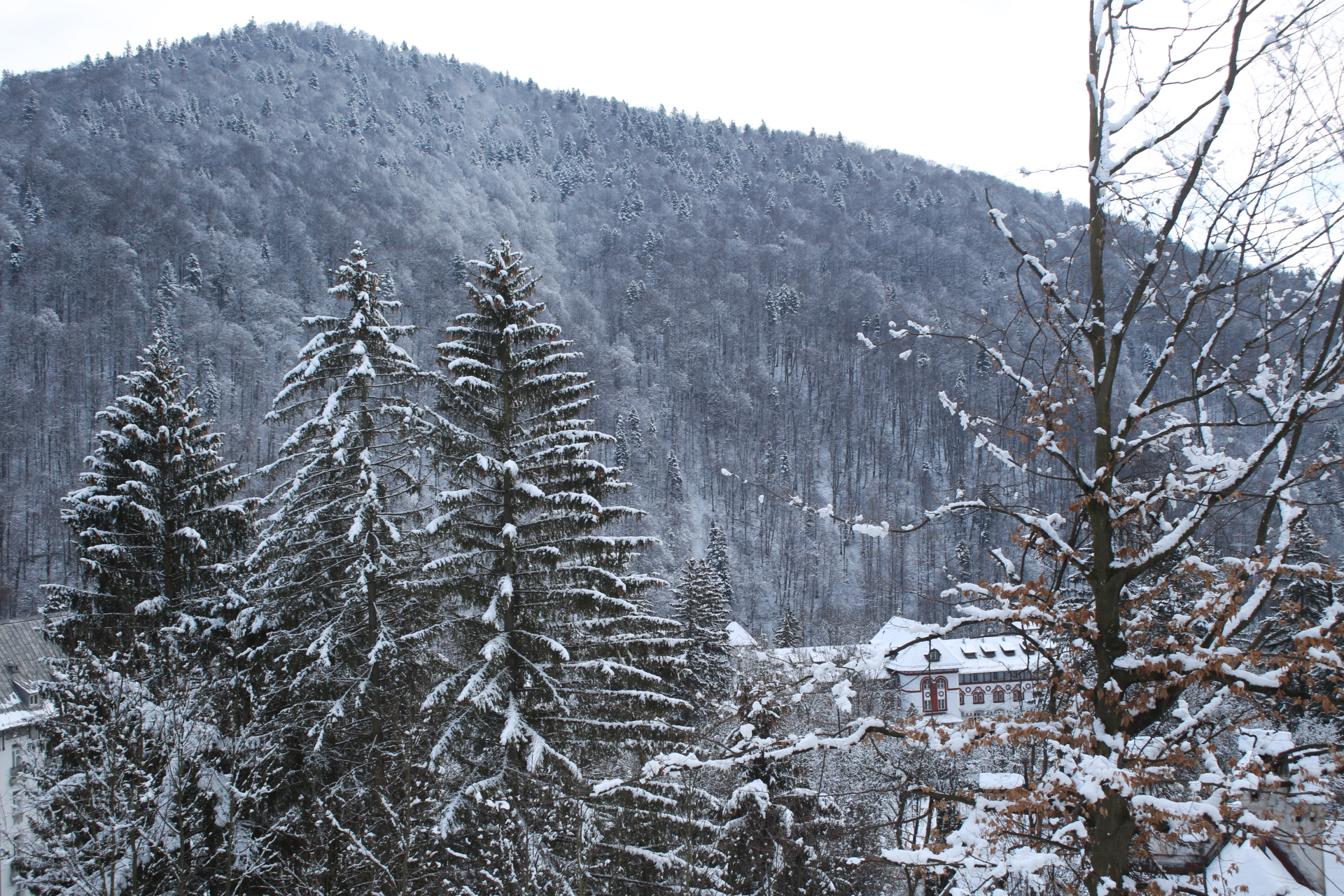Portret de voluntar – Ravaka (Franţa)
Hello ! My name is Ravaka. I am 25 years old and I come from France. I love listening to music so this is what I do most of the time when I’m by myself. I am passionate about South Korea and some other countries in Asia such as Japan and Thaïland… I am curious about History and Cultures of the world in general. I like speaking and learning foreign languages. I also very much enjoy learning about the different ways of living and the customs there are in the world. This is one of the reasons I love traveling. Another reason is that I am a bit adventurous.
Being able to live and grow in an unknown environment is the main reason I decided to involve myself in a volunteering project abroad. It is a way of challenging myself which I felt I needed to do. Then I find it very motivating to be working with other young people on a project that would benefit many people. Since I have never done anything like this before, except from some volunteering work as a student, I found that a 2 months volunteering project was right for me to start my volunteering journey. Also, I heard we could go hiking and I can’t wait to do that !
I hope this experience will be positive and I feel grateful to be here in this year of 2021.

Buna ! Numele meu este Ravaka. Am 25 de ani și vin din Franța. Îmi place să ascult muzică, așa că fac asta de cele mai multe ori când sunt singur. Sunt pasionat de Coreea de Sud și de alte țări din Asia, cum ar fi Japonia și Thailanda … Sunt curios de Istoria și Culturile lumii în general. Îmi place să vorbesc și să învăț limbi străine. De asemenea, îmi place foarte mult să învăț despre diferitele moduri de viață și obiceiurile care există în lume. Acesta este unul dintre motivele pentru care îmi place să călătoresc. Un alt motiv este că sunt un pic aventuros.
A putea trăi și crește într-un mediu necunoscut este principalul motiv pentru care am decis să mă implic într-un proiect de voluntariat în străinătate. Este un mod de a mă provoca pe mine, pe care am simțit că trebuie să îl fac. Apoi mi se pare foarte motivant să lucrez cu alți tineri la un proiect care ar aduce beneficii multor oameni. Din moment ce nu am mai făcut așa ceva, cu excepția unor activități de voluntariat ca student, am constatat că un proiect de voluntariat de 2 luni mi-a fost potrivit pentru a-mi începe călătoria de voluntariat. De asemenea, am auzit că putem face drumeții și abia aștept să fac asta!
Sper că această experiență va fi pozitivă și sunt recunoscător să fiu aici în acest an din 2021.
Easter in Teișani
Această reflecție asupra sărbătorilor pascale a fost pregătită în comun de Josué și Gertrudis, voluntarii noștri din Spania din cadrul proiectului Discover Teișani. Tradus de Alex Popa.
Chiar dacă România face parte din Europa și în unele aspecte nu atât de diferită de țara noastră, in același timp ai senzația de a fi într-o realitate ieșita din comun. Ca exemplu, odată cu Paștele întâlnim – cea mai mare sărbătoare creștină – sentimentul este că probabil ați mai văzut un lucru asemănător, dar este în același timp unul deosebit, deoarece biserica de aici este o biserica ortodoxă, se aseamănă celei catolice, care este cea cu care noi suntem obișnuiți. Aceasta este prima noastră experiență cu partea necunoscuta de noi a creștinismului.Am avut oportunitatea sa ne bucuram pentru prima oara de Pastele Tradițional Romanesc in satele Teișani si Olteni. Am fost anunțați ca aici festivitatea Paștelui este urmat de vechiul calendar ortodox, asta înseamna ca anul acesta, Duminica Învierii a fost situata pe 25 aprilie.
Prin urmare, este un lucru în comun să vedem cum familiile se pregătesc pentru această zi prin fierberea ouălor și prin colorarea lor cu vopsea specială pentru coajă ouălor.Am descoperit procesul alături de un voluntar local care ne-a explicat că vopsirea ouălor poate fi realizată și prin utilizarea cepei. Alegerea culorii roșii este cea mai comună, deoarece evocă sângele lui Isus Hristos.
Joia, vinerea și sâmbătă, înainte de Duminică Învierii, are loc o slujba dedicată Paștelui. Joi, liturghia este mult mai lungă decât de obicei, preotul citește cele 12 povești ale Evangheliei, câte unul pentru fiecare apostol. Am luat parte la această liturghie și a fost interesant cum a trebuit să “reînvățăm” procesul bunelor maniere din biserica datorită faptului că sunt total diferite de cele pe care le urmăm în țară fiecărui dintre noi. Din fericire am avut un localnic dornic cu noi explicând tot ceea ce aveam nevoie să știm pentru nu arată prea mult străini ;). La final, noi și restul oamenilor am primit o sticlă de suc de portocale pentru această ocazie excepțională.
Cea mai impresionantă zi pentru noi a fost sâmbătă. La începutul liturghiei, care începe în jurul orei 12 noaptea, oamenii cântă și împart focul lumânărilor pentru a le aprinde, începând cu lumânarea mare pe care o ține preotul. După un timp, oamenii merg la cimitir cu lumânările lor și le lasă acolo. Este momentul să petrecem câteva minute amintindu-ne de strămoșii lor care au murit. De dată această în cimitir merg să își amintească de oamenii care au fost aproape de ei, însă aici nu mai este vedere doar sărbătoarea de Paști cum suntem obișnuiți noi în Spania. Chiar și pentru unii români cu care am vorbit, care nu sunt din comună, este curios. În plus, putem spune că rezultatul merită văzut și este locul unde ne punem eforturile pentru a surprinde magia acestui moment, la biserica.
Am insotit o familie in cimitirul Teișani în acel moment. Încă auzeam sunetul oamenilor cântând în biserică. Apoi, ne-am întors și slujba s-a terminat pe la 02:30. Cu toate acestea, slujba obișnuia să se termine mai târziu, dar de data aceasta pentru măsurile Covid au terminat totul putin mai devreme.
De-a lungul nopții ne-am dat seama de faptul că nu văzusem cu adevărat comună Teișani noaptea până atunci din cauza stării de urgență. În această zi Teisani, a fost aglomerat dacă l-am compară cu restul zilelor ale acestui an. A fost frumos să vedem tineri stand în jurul nostru vorbind pentru a profită de ocazia specială care ne aduce aici.
A fost cu adevărat impresionant și să rămânem în cimitirul din Olteni mai târziu, acolo nu era nimeni și era foarte liniște. De la această liturghie și timp de 40 de zile, este obișnuit că oamenii să se întâmpine cu «Hristos a Înviat!» și ei răspund cu «Adevărat un înviat!».
Even if Romania is part of Europe and in some aspects not that different from our country, at the same time you have the feeling of being in a different reality. For example, with Easter – the biggest Christian celebration – the feeling is that you have seen this before but it is at the same time different since the one here is the Orthodox churchunlike the Catholic one which is the one we are used to. This is our first experience with the astern part of the Christianism.
We had the opportunity of enjoying Romanian Easter for the first time in the villages of Teișani and Olteni. We have been informed that Easter festivity follows here the old Orthodox calendar, which means that this year the Resurrection Sunday, the most important day for this fest, was on the 25th of April.

Therefore, it is common to see how families prepare for that day by dying boiled eggs with special ink for the shell of the eggs. We discovered the process with a local volunteer that explained to us that the dying can also be made with onions. The red choice for the eggs is the most common because it evokes the blood of Christ.

On Thursday, Friday and Saturday before the Resurrection Sunday, there are special mass. On Thursday, the mass is longer than usual, the priest reads twelvefold of the gospel, one for each apostle. We visited that mass and it was interesting how we had to “relearn” the process and manners in the church due to they are different from the ones we used to follow in our country. Luckily we had a local with us explaining all what we needed to know not too look too much like foreigners ;). At the end, we and the rest of people received a bottle of orange juice for this exceptional occasion.
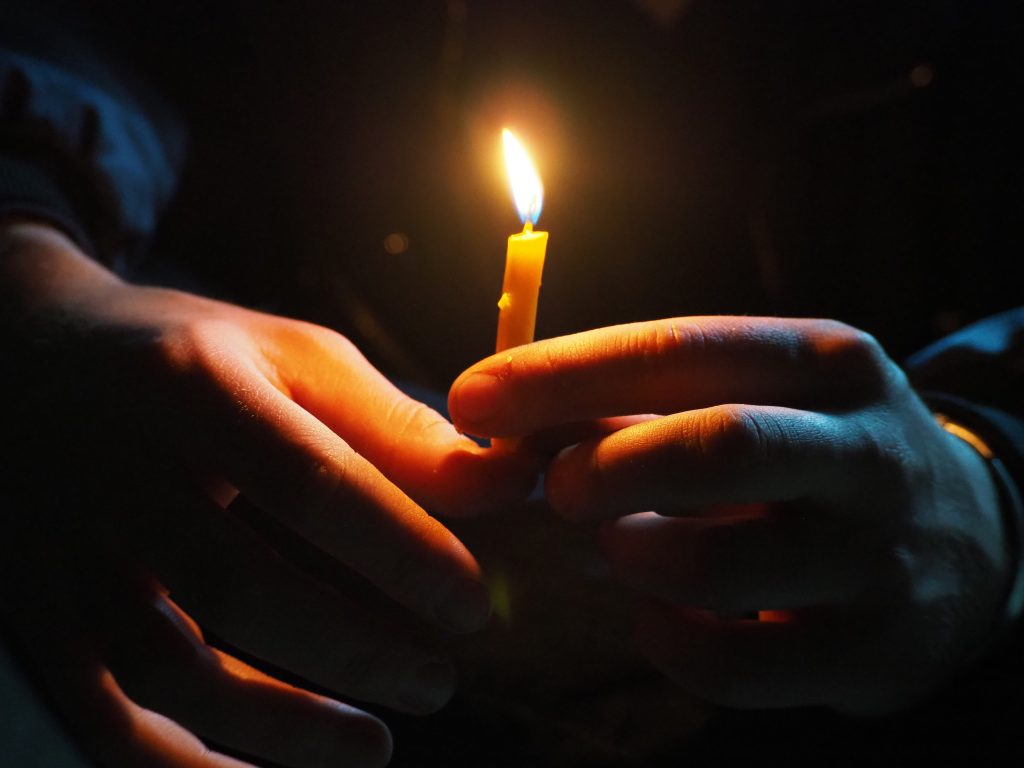
The most impressive day for us was Saturday. At the beginning of the mass, which starts about 12h in the night, people sing and share the fire of their candles to light them up, starting with the big candle that the priest holds. After a while, people go to the cemetery with their candles and they let them there. It is the moment to spent some minutes remembering their ancestors who passed away. This time in the cemetery to think about the people who were close to us but are not anymore is not sight in the Easter fest that we are used to in Spain. Even for some Romanians who we have talked with but are not from the commune it is curious. Besides, we can say that the result is worthwhile to see, and it is where we put our efforts to capture the magic of this moment.
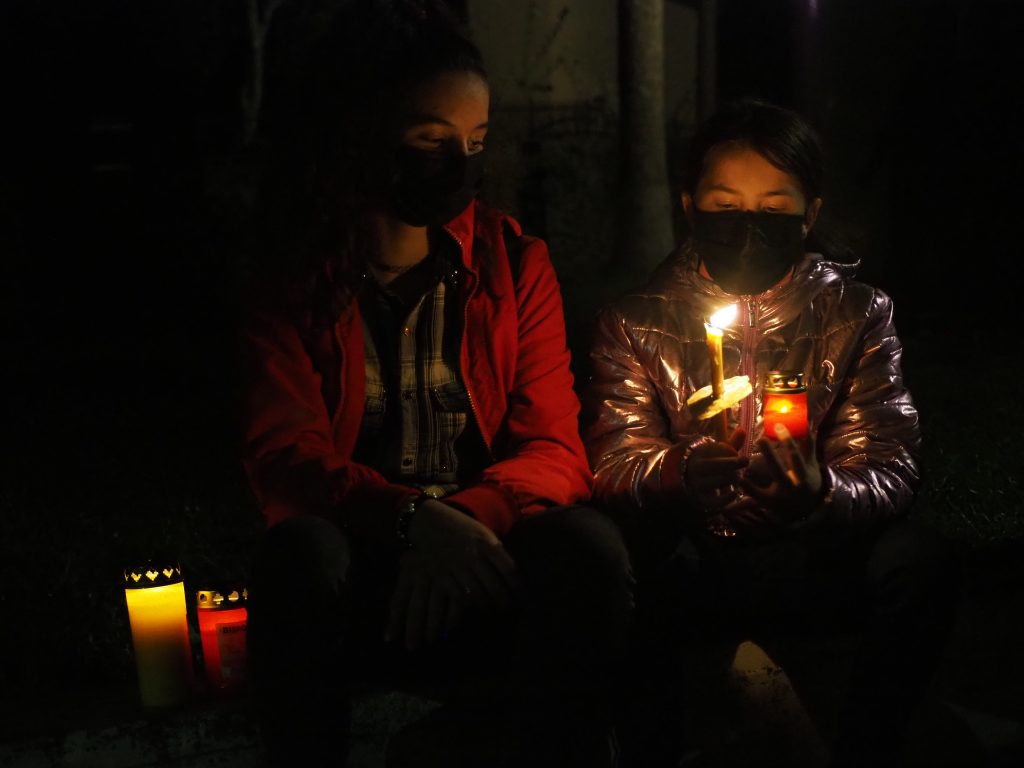
We acompannied a family to the Teișani’s cementery in that moment. We could hear still the sound of people singing in the church. Then, we came back and the mass finished about 2:30h. Nevertheless, the mass used to finish later, but this time for Covid measures they finished earlier.
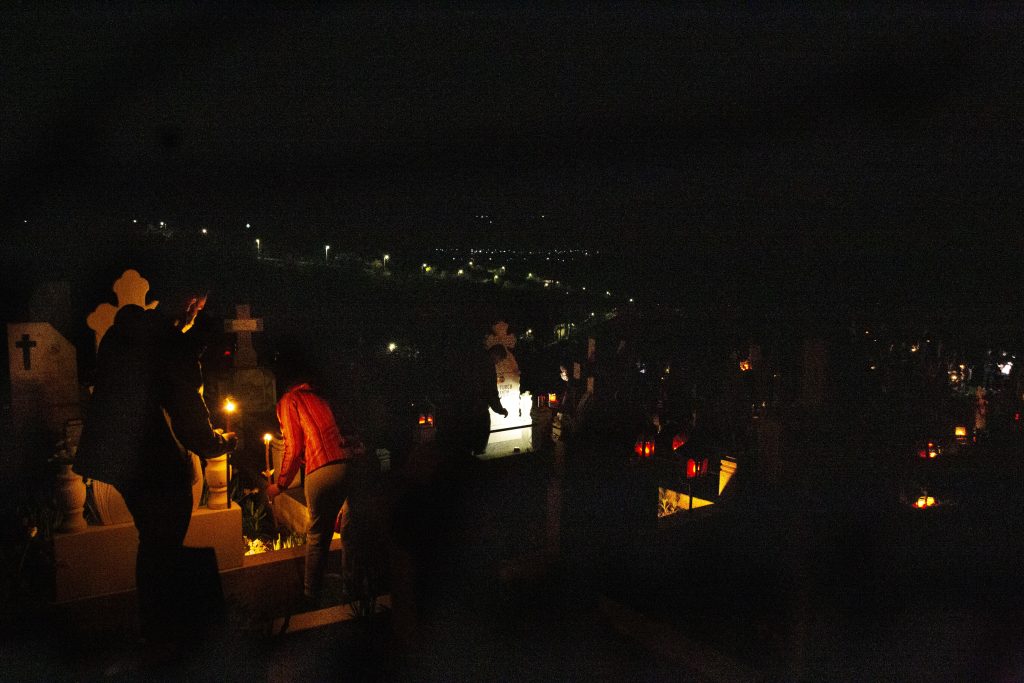
Along the night we realised the fact that we had not really seen Teișani at night until then because of the curfew. This day Teisani was crowded if we compare it with the rest of this year. It was nice to see young people hanging around taking profit from the special occasion that brings us here.

It was really impressive also to stay in the cementery of Olteni later, were there was no one and it was really quiet. From this mass and during 40 days, is common that people greets themselves with «Hristos a Înviat!» (Christ has risen) and they answer «Adevărat a înviat!» (Indeed he has risen).
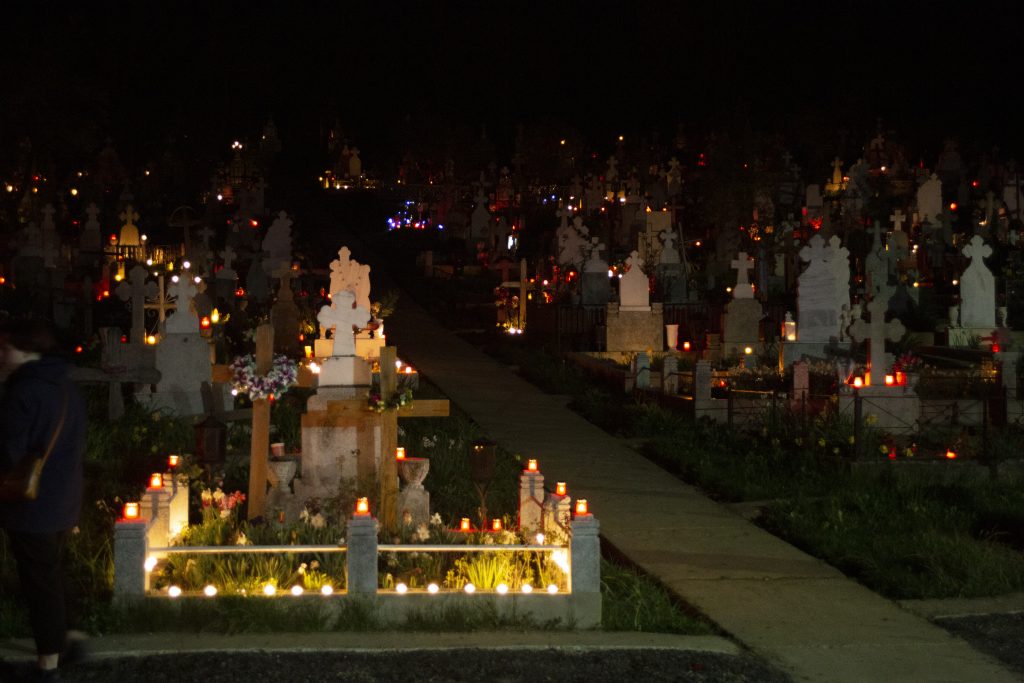

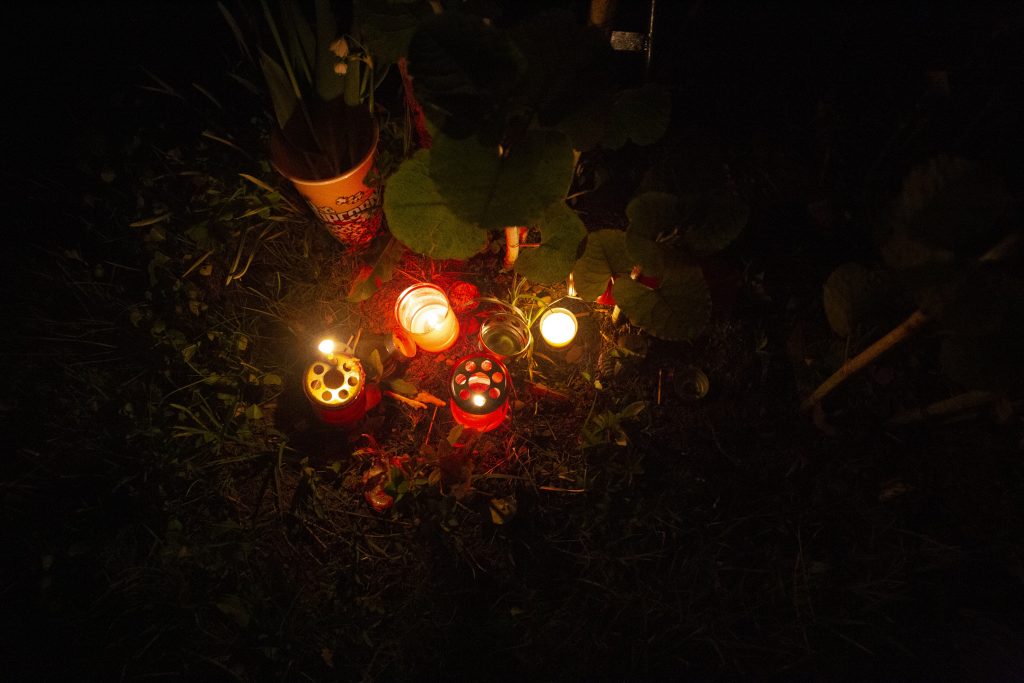

Of cats and dogs
Living with a former farmer/hunter as a dad, I grew with dogs and cat, but I have never seen as many dogs and cats as I have since I got to Romania. So I thought I should take some photos of mans best friends.

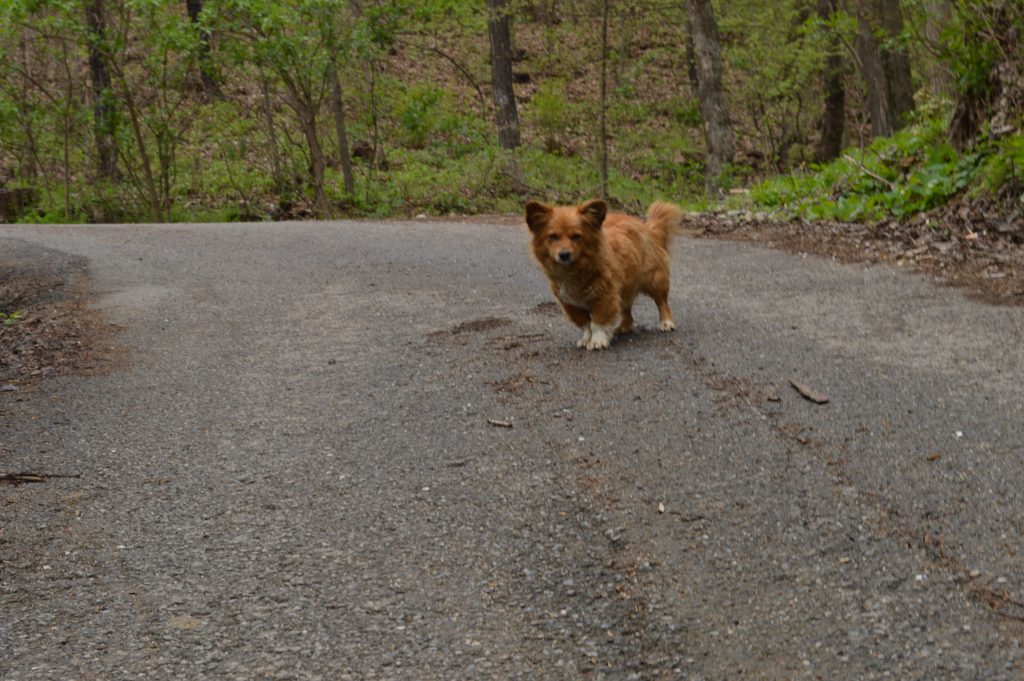

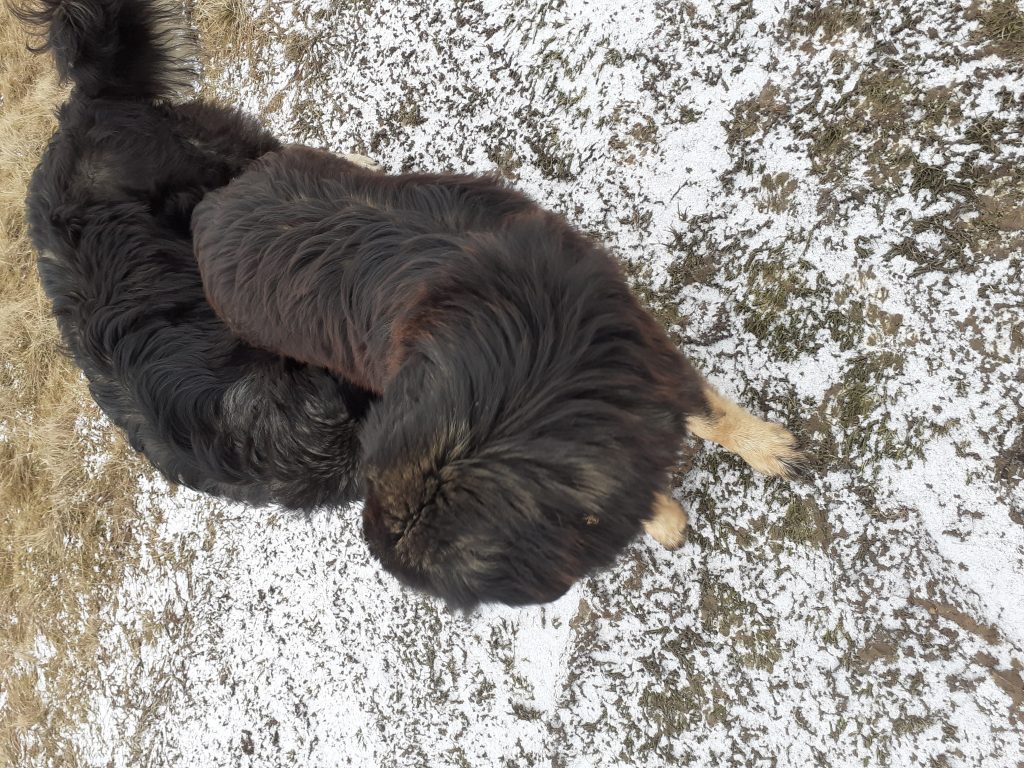
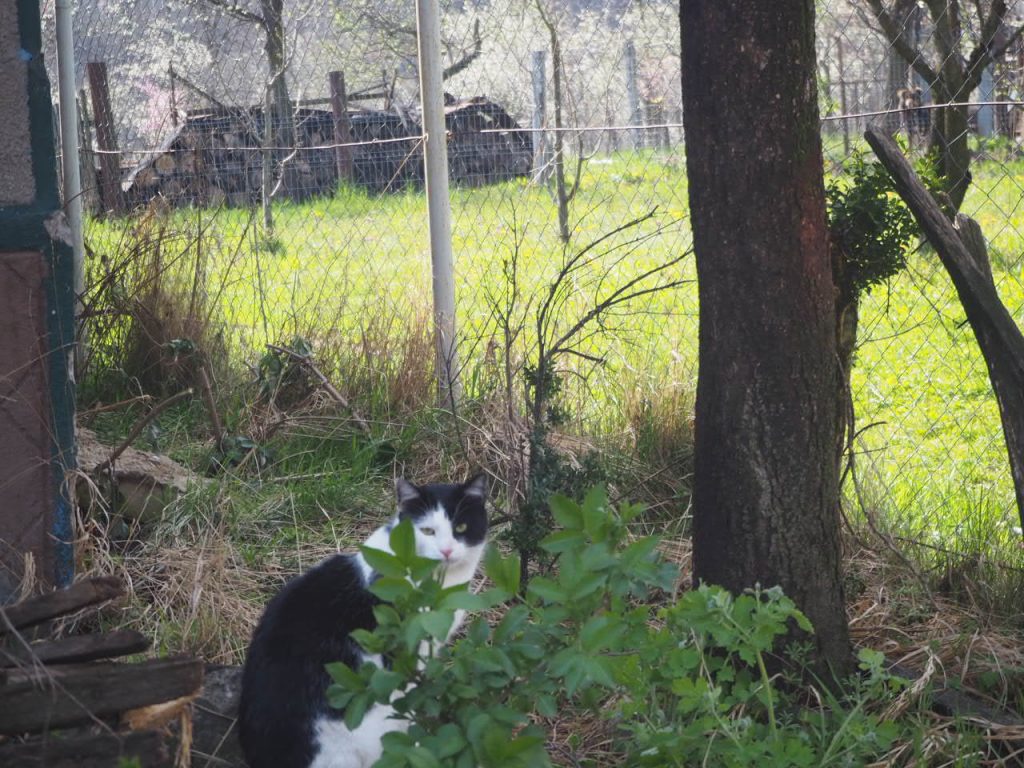
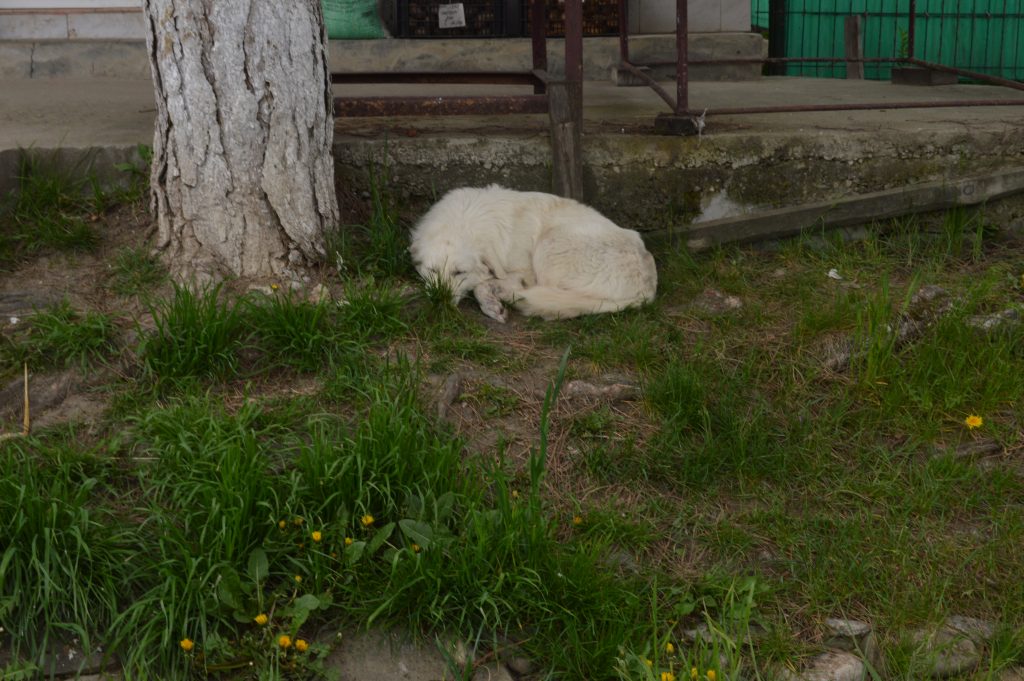
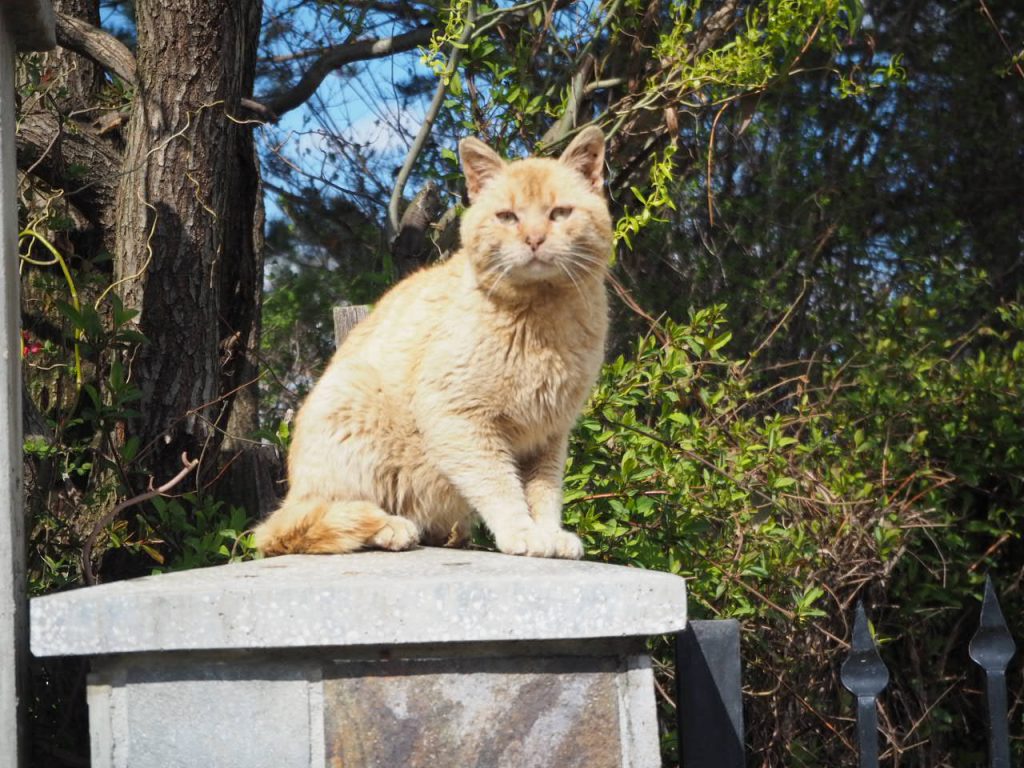
Noua iarnă / New winter
/Josue a scris acest articol în engleză. Mulțumim lui Georgian pentru traducere. /
Suntem acum în mijlocul celei mai ciudate ierni din viața noastră, cel puțin așa a fost pentru mine, nu numai pentru situația pandemică internațională, ci și din cauza experiențelor pe care le-am trăit și a oamenilor pe care i-am cunoscut. În mod ironic, am crezut că anul acesta a fost un moment bun nu pentru călătorii, ci pentru a mă muta într-o altă țară în calitate de membru al programului corpurilor europene de solidaritate. Să fim sinceri: să faci voluntariat în altă țară, să înveți lucruri noi, să cunoști oameni noi, este mult mai bine decât să stai acasă în orașul tău obișnuit, asistând la lecții online. Așadar, voi împărtăși aici o parte din experiența mea ca străin în România rurală.
We are now in the middle of maybe the weirdest winter of our lives at least it has been like that for me, not only for the international pandemy situation but also because of the experiences I´ve lived and the people I´ve met. Ironically I thought that this year was a good moment not for travel but to move to a different country as member of europen solidarity corps. Let´s be honest to volunteer in another country learning new things knowing new people is far way better than stay at home in your usual city assisting to online lessons. So, on this occasion I´m going to tell you part of my expirience as foreingner in rural Romania.
Căci cine nu știe, eu sunt Josu și vin dintr-o parte mai uscată a lumii, nu este ca și cum aș fi „tuareg” care trăiește în deșert, dar să spunem că în patria mea peisajul era verde iarna și galben vara.
For who doesn´t know, I´m Josu and I´m coming from a drier part of the world, it´s not like I´m a “tuareg” who lives in the desert but let´s say that in my homeland the landscape used to be green in winter and yellow in summer.
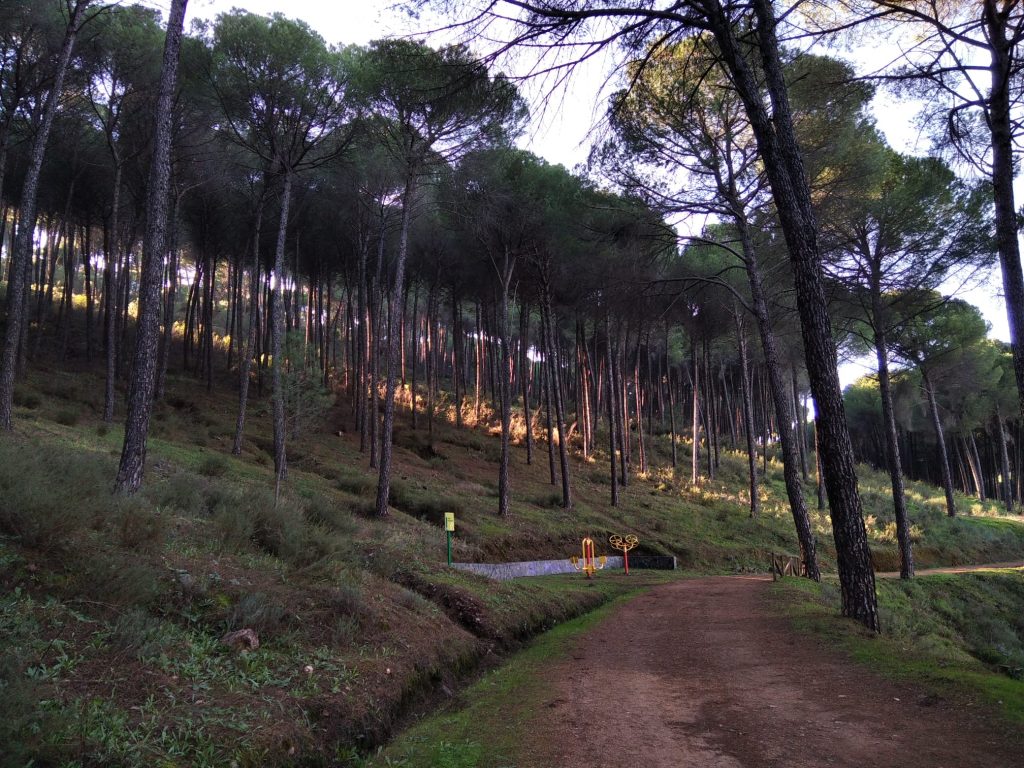
După ce am primit în sfârșit documentele mele spaniole pentru prima dată, am cumpărat un zbor pentru a veni în România pe 7 ianuarie. Am ajuns deja pe 8 dimineața devreme și, ca să fiu sincer, m-am așteptat să fie puțin mai rece când am ieșit din avion, dar au fost aproximativ 2 ° C. Era într-adevăr frig, dar putea fi și mai rău. Acolo de unde vin această temperatură ar putea fi cea minimă, uneori ajunge la 0 ° C, dar nu este niciodată suficient de rece ca să ningă. Totuși, în acea zi m-am întâlnit cu coordonatorul meu care a venit să mă ia și am început drumul spre Izvoarele. Drumul părea același ca atunci când venisem prima dată vara, același drum, aceleași case și aceleași altare deoparte, de asemenea adânc în noapte. Pur și simplu era mai frig.
After I got finally my Spanish documents for the first time I bought a flight to come to Romania on 7th of January I arrived already on 8th in the early morning and to be honest I expected it to be a little bit colder when I got out from the plane but it was like 2ºC. It was cold indeed but it could be worse. Where I come from that temperature could be the minimum, sometimes we reach 0ºC but it´s never enough to snow. However, that day I met my coordinator who came to pick me up and we started the way to Izvoarele. The way seemed the same than when I came the first time on summer, the same road, the same houses and the same shrines aside, also deep in the night. It just was colder.
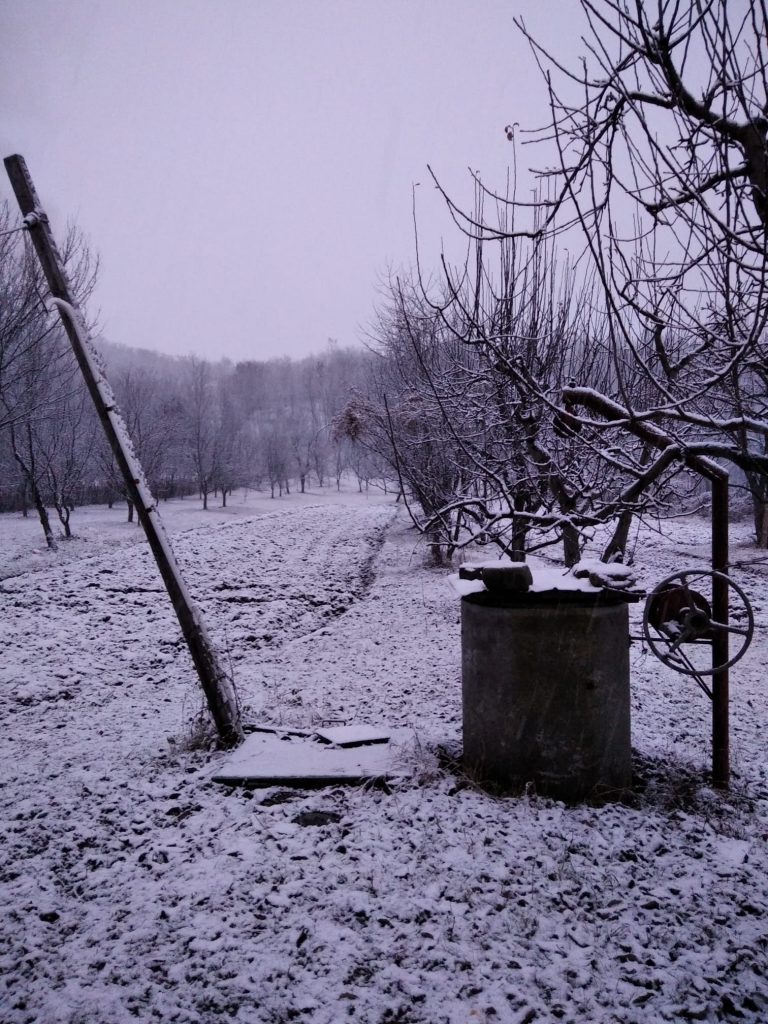
Am ajuns la noua mea casă gazdă în jurul orei 04:30 și, deși eram obosit, nu aveam somn, așa că am decis să mănânc ceva și să mă uit la ceva distractiv în laptop. Încercam doar să mă linistesc și să mă simt confortabil până când brusc m-am uitat pe fereastră. Nu mă așteptam ca lumina ușoară a zorilor să mă lase să văd că ningea de când am intrat în casă și curtea era deja complet albă. Știu că acest lucru trebuie să sune prost și foarte normal pentru o mulțime de oameni, dar dacă vă spun că nu am văzut niciodată că ninge până atunci? Adică am văzut zăpada doar o dată, dar nu ningea cu adevărat și era într-un loc în care nu existau multe elemente în jurul meu, cum ar fi case, copaci, oameni … în afară de asta a fost acum nouă ani așa că…
I arrived to my new host house at around 4:30 AM and even though I was tired I was not really sleepy so I decided to eat something and watch something entertaining in my laptop. I was just trying to chill and make myself comfortable until suddenly, I looked through the window. I didn´t expected the slight light of the dawn to let me see that it had been snowing since I got into the house and the yard was already completely white. I know that this must sound silly and super normal for a lot of people but, what if I tell you that I never saw it snowing until then? I mean, I only saw the snow once but it was not really snowing and it was in a place where there was not a lot of elements around me such as houses, trees, people… besides it was nine years ago so…
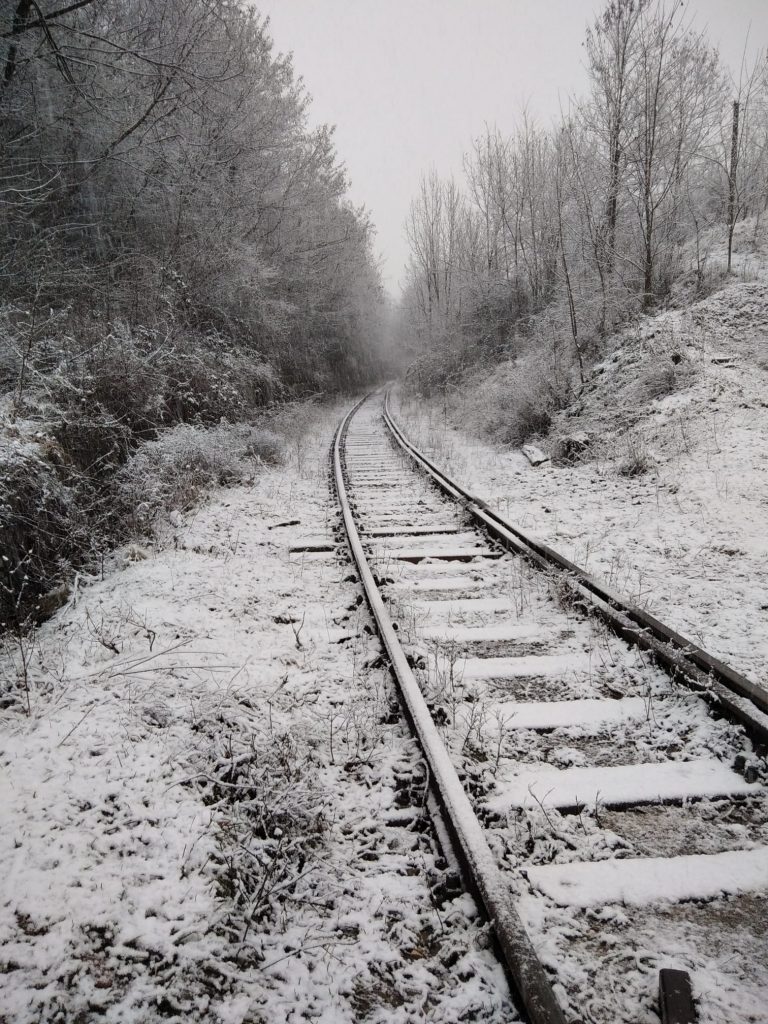
Oricum, bineînțeles văzând că am decis să merg la plimbare pentru a cunoaște mai bine noul meu sat începând din curtea mea. Terminând acolo, m-am aventurat pe stradă și am început să merg. La un moment dat mă întorc în lateral și am intrat într-o mică „stradă” sau mai bine pe o potecă, care este traversată la un moment dat de șinele de tren. Imaginea aceea dintr-o clipă mi-a amintit de scena clasică a unui tren care trecea prin filmul peisajul alb al Europei de Est
Anyways, of course seeing that I decided to go for a walk to get to know better my new village starting from my own yard. Finishing there, I ventured out the street and started to walk. At some point I turn to the side and got into a little “street” or better yet a path which is crossed at some point by the traintracks. That image by a moment reminded me of the classic scene of a train going through the white countryside of the eastern europe in the movies.
După câteva minute de coborâre, tocmai m-am lovit de râul Crasna, cel care dă numele străzii mele și acelei frumoase mănăstiri de dincolo de Schiulesti. Doar să menționez că a fi acolo toamna a fost ca și cum ai fi fost într-un basm.
After some minutes going downhill I just bumped into the Crasna River, the one which gives the name to my street and that beautiful monastery beyond Schiulesti. just mention that being there on Autumn was like immerse oneself into a fairytale.
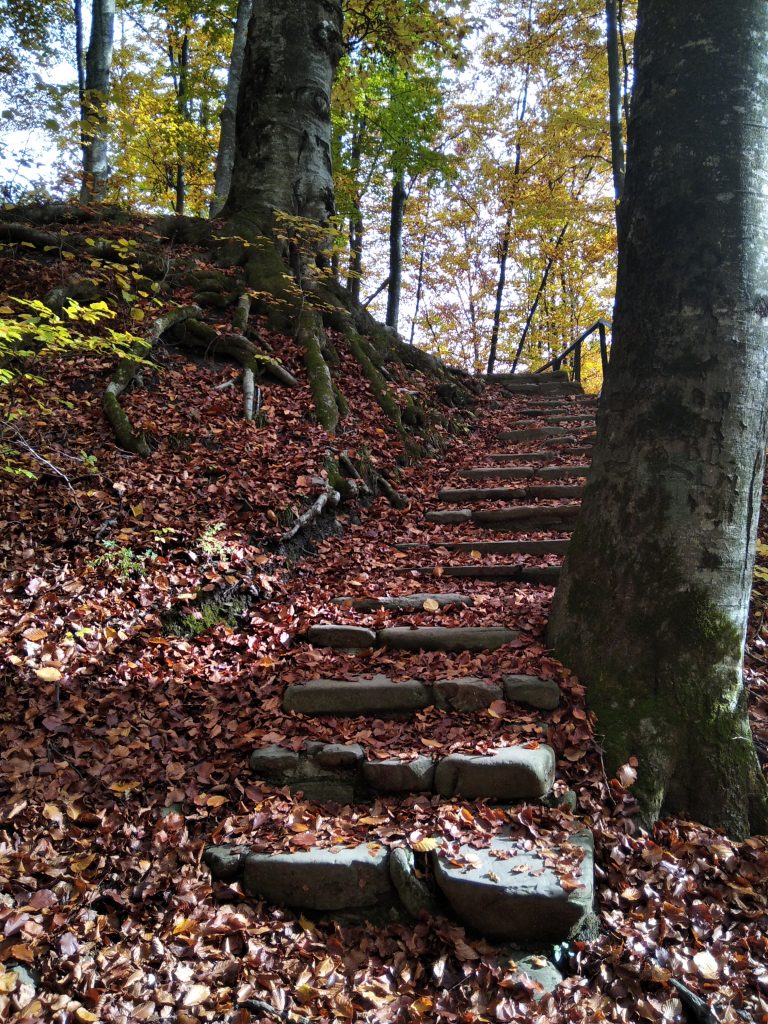
În cele din urmă, pe măsură ce ningea și am început să-mi ud blugii, am decis să mă întorc acasă la casa mea confortabilă pentru a încerca să ma încălzesc. Mi-a plăcut România vara,toamna, dar mi s-a părut frumos peisajul acoperit de zăpadă. Sunt sigur că o să mă bucur de primăvară aici. De asemenea … Da, este foarte frumos să folosești lemnul și să faci foc singur pentru a-ți încălzi casa, dar … Haide, încă douăzeci de grade nu sună așa de rău, nu?
Eventually as it kept snowing, and I started to get my jeans wet I decided to go back home to my cozy house to try to warm it up. I liked Romania on Summer also in Autumn, I found the snow-covered countryside beautiful. I´m sure I´m going to enjoy the spring here. Also… Yeah, it´s very nice to use wood and make fire yourself to get your house warm but… Come on, twenty degrees more doesn´t sound that bad, eh?
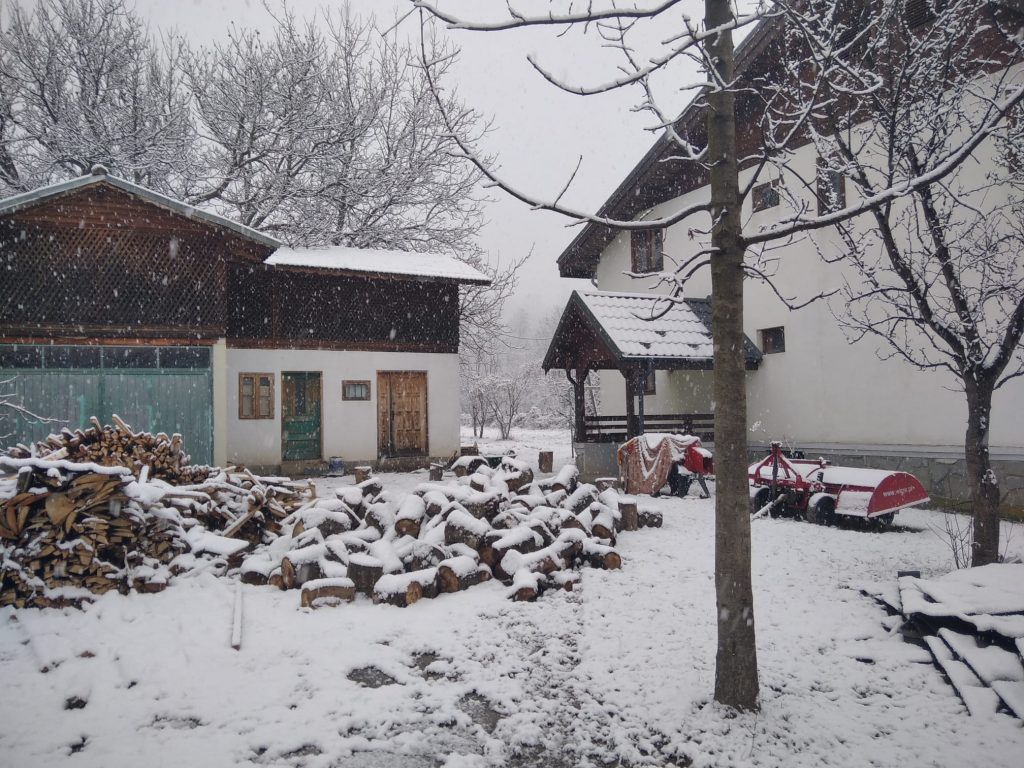
Portret de voluntar – Paco (Franţa)
Bună, mă numesc Paco, am 21 de ani și vin din estul Franței, nu departe de Strasbourg.
După bacalaureatul științific, am făcut doi ani la Strasbourg la Universitatea de Științe Tehnice a Activităților Fizice și Sportive. Au fost doi ani grozavi, foarte plini de satisfacții, dar în cele din urmă mi-am dat seama că vreau să fac ceva mai concret. Așadar, când trebuia să-mi reiau al treilea an, am decis să fac o pauză și să mă reorientez, de aceea am candidat pentru un loc de muncă mai aproape de orașul meu natal: Mulhouse. Am lucrat timp de 8 luni într-un supermarket și foarte repede am reușit să mă confrunt cu ritmul și cerințele unui loc de muncă cu normă întreagă. Am renunțat pentru că am vrut să mă implic în alte proiecte.
În prezent sunt în România la Izvoarele pentru un proiect de serviciu civil de 12 luni. Am decis să vin la asociația Curba de Cultură pentru că am avut deja ocazia toamna trecută să fac parte din proiectul de 2 luni de la Teisani, unde am renovat un centru de tineret. Acest proiect a fost uimitor pentru că am putut să învăț o mulțime de abilități, informații și mai presus de toate am ajuns să cunosc oameni noi și frumoși. În acest an mă voi putea implica în mai multe proiecte, cum ar fi descoperirea Teisaniului, cu scopul de a face o monografie, de a organiza activități cu centrul mobil de tineret și de a lucra în jurul sarcinilor zilnice de la Curba de Cultură …
Am avut ocazia să călătoresc în viața mea, dar niciodată cu ideea de a rămâne 1 an în aceeași țară, așa că sper că anul acesta îmi va permite să înfloresc, să învăț și să descopăr o mulțime de lucruri. Dar am încredere.
Hi, my name is BLIND-CEROI Paco, I am 21 years old and I come from Eastern France not far from Strasbourg.
When I had my scientific baccalaureate, I went straight to two years in Strasbourg at the University of Technical Sciences of Physical and Sports Activities. It’s been two great, very rewarding years, but finally I realized that I wanted to do something more concrete. So when I had to resume my third year I decided to take a break and reorient myself, that’s why I applied for a job closer to my hometown: Mulhouse. I worked for 8 months in a supermarket, and very quickly was able to be confronted with the pace and the demands of a full-time job. I quit because I wanted to get involved in other projects.
Currently I am in Romania in Izvoarele for a civic service of 12 months. I decided to come to the Curba de Cultura association because I already had the chance last fall to be part of the 2-month project in Teisani, where we renovated a youth center. This project was amazing because I was able to learn a lot of skills, information and above all I got to know new beautiful people. During this year I will be able to get involved in several projects such as the discovery of Teisani with the objective of making a monograph, organizing activities with the mobile youth center, and working around the daily tasks at Curba de Cultura…
I had the opportunity to travel in my life but never with the idea of staying 1 year in the same country, so I hope that this year will allow me to flourish, learn and discover a lot of things . But I trust it.
Doi străini trăind sărbătorile de crăciun în România
/Andrea și Gertrudis au scris acest articol în engleză. Pentru a citi originalul, vezi textul mai jos./
Noi suntem Gertrudis și Andrea, voluntari ai asociației ‘’Curba De Cultură’’ aici în România, mai exact în comuna Izvoarele (Prahova). De-a lungul acestui an, suntem implicați în proiectul ‘’Discover Teisani’’ (Descoperă Teișani): inițiativă pentru a promova comuna și locuitorii Teișaniului utilizând conținut audio-vizual, articole și multe alte materiale. Cu toate astea, astăzi suntem aici pentru a vorbi despre altceva.
Acest articol este pentru toți cititorii curioși ce vor să știe cum se sărbătorește în alte țări de Crăciun și Anul Nou. Vom vorbi despre ceea ce am văzut, despre experiențele trăite, despre senzațiile și sentimentele pe care le-am trăit în primul nostru festival ca străini.
Toată lumea știe că venirea Crăciunului este deseori sinonim cu apariția decorațiunilor: orice tip de ornamente, lumini și LEDuri de toate formele și culorile, Moși Crăciuni tăcuți în mijlocul de a se cățăra pe fiecare terasă… Din experiențele noastre trecute am crezut că le-am văzut pe majoritatea. Ne-am înșelat, căci din păcate nu fusesem în România înainte. Să spunem că a fost incredibil nu e suficient, felul cum de pe-o zi pe alta fiecare casă s-a aprins, transformând strada liniștită de țară în ceva mai similar cu felul cum ne imaginăm că ar fi o stradă din cartierul chinezesc (Chinatown).
Puteam deja în acele zile să simțim spiritul Crăciunului sau, cel puțin, puteam simți că etapa pregătitoare era în curs de desfășurare. Apoi, zi după zi, din ce în ce mai mulți oameni au început să se deplaseze spre sat. Mai multe strigăte, mai multă muzică, mai mult petrecut. Cu toate astea, momentul exact în care am perceput în sfârșit că e sărbătoare a fost trezitul în acea dimineață înmuiată de un cântec, canto. Am descoperit ulterior că am auzit ”colindatul”, colindele de Crăciun. În esență această tradiție constă într-un grup de persoane cântând la instrumente și vocal cântece, aceștia mergând din casă în casă. Originar, colindele de Crăciun aveau funcție de ritual, mai exact aceea de a ura fertilitate și abundență. Astăzi, scopul comun al colindelor este acela de a alunga spiritele rele ale lui ianuarie și de a ura un Crăciun și An Nou fericite, creând o atmosferă colorată și magică.
Crăciunul se apropia, iar satul era în priză. Aerul era acum plin de pocnitori, muzică tradițională și pocniturile biciurilor fluturate de băieți. Ultima dintre acestea, la fel ca în cazul colindelor de Crăciun, este o tradiție bine fondată: băieții flutură un bici lung în aer, producând pocnituri tunătoare. Primele câteva dăți când am auzit acel sunet am crezut că erau focuri de armă. Sună destul de puternic, și chiar este, pentru a alunga spiritele rele.
Neașteptatul punct culminant al sărbătorilor a venit de Ajunul Anului Nou. Nu am fi crezut niciodată că odată cu miezul nopții cerul de deasupra Izvoarelor va fi colorat de o multitudine de artificii. Pentru acele minute intense artificiile au apărut dintr-o parte în alta, fără răgaz. Până și casa din fața noastră a decis să ia parte în acest dans. Odată cu căderea cenușii lăsate de artificii am mers în stradă, purtând măști și, purtați de euforie, am cunoscut doi copii care erau și ei purtați de euforia de a cunoaște străinii din zonă. A durat ceva, puține cuvinte dar multe gesturi, și ne-am trezit absorbiți într-un dans, condus de copii. Într-un cerc, ținându-ne unii de alții, am urmărit muzica care nu ne-a părăsit vreodată, mereu în fundal. A fost un final potrivit, un rămas bun al anului care ne-a lăsat într-o dispoziție pozitivă de care aveam nevoie pentru a continua planificarea următoarei explorări.
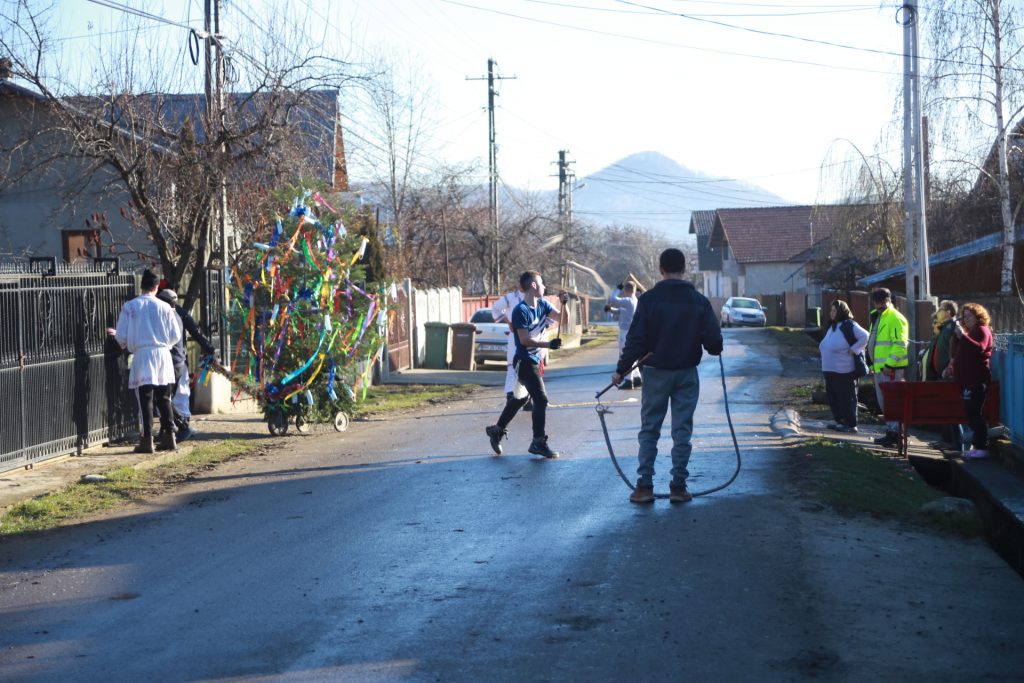
Desigur, drumețiile în zonele din jur a fost absolut obligatorie. Prahova este un județ minunat pentru cei care iubesc natura. Numai în Izvoarele era un traseu liniștit mergând spre Schiulești și, odată acolo, poți continua până la Mănăstirea Crasna. Pe lângă asta, a meritat să vizităm dealurile din Teișani. Iarna oferă o atmosferă magică odată ce se așterne zăpada, dar chiar și înainte te poți bucura de diversitatea culorilor ce rămân din timpul toamnei. Am mers în drumeție de asemenea în SInaia, unde a fost surprinzător de liniștit. Deși tot turismul din Sinaia pare concentrat pe schiat, cărările pentru a ajunge la nivelul de 1450 m erau goale, iar noi am avut sentimentul că toată imensitatea naturii era pentru noi. Cu siguranță, trebuie să fi pregătit cu energie și pantofi potriviți pentru un astfel de plan. Cu toate astea, poți de asemenea găsi și activități mai relaxante în Sinaia, precum vizitarea castelului Peleș. Acolo, îți vor fi introduse un mix de stiluri (turcesc, maur, venețian, al lui Louis IV…) și rafinatul lucru în lemn care caracterizează clădirea.
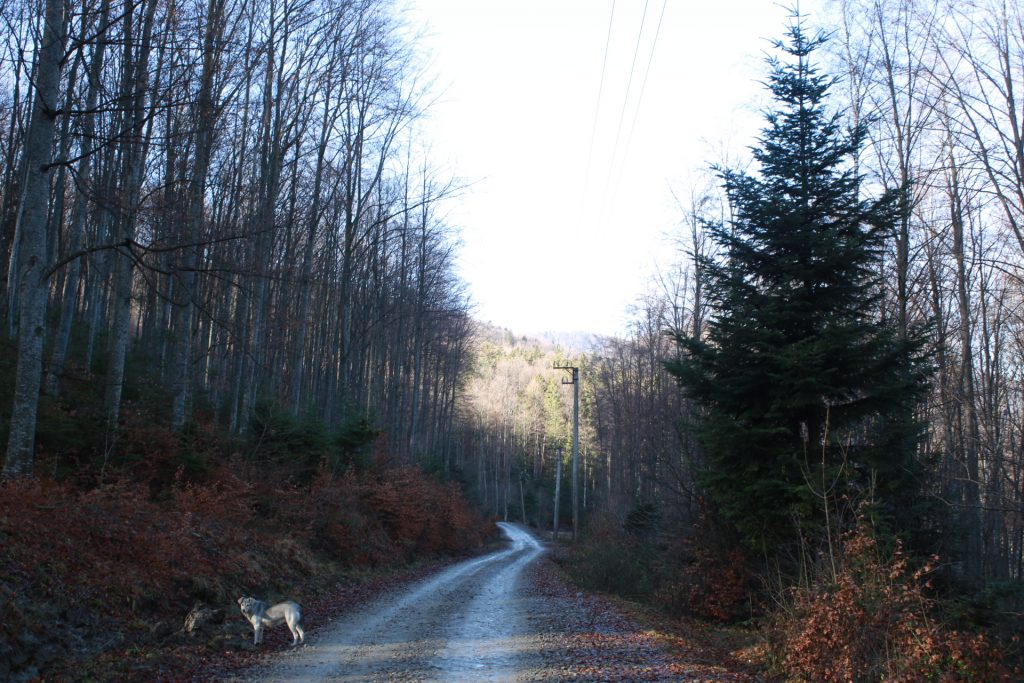
Nu putem termina fără să menționăm că am avut șansa să vizităm Bucureștiul în timpul sărbătorilor. Ne-a dat o impresie similară a unui loc plin de viață cu un mix interesant de stiluri în ceea ce privește clădirile. Nu în același fel, dar de asemenea atractiv. Cu cantitatea de lumini, noaptea a fost îndeosebi vie în centrul vechi. A trebuit să fim în capitală pentru a ajunge în Sinaia cu trenul. Am avut norocul de a ne urca într-un tren internațional istoric și frumos spre Viena, unul cu compartimente separate. Cu siguranță trenurile din România merită un alt articol în viitor.
În scurtul timp în care am fost în București, am putut vizita câteva librării. Acestea erau pline de decorațiuni șic de Crăciun. Cu toate astea, privirile noastre au mers direct spre rafturi de parcă căutau comori. Aceste locuri, la fel ca și bibliotecile, par să păzească într-un loc spațiu foarte mic o cantitate enormă de cunoaștere despre cultura unei țări. Nu doar datorită conținutului cărților în sine, dar și prin felul cum rafturi sunt așezate, subiectele și autorii de care sunt interesați..
În concluzie, suntem fericiți că acesta este doar începutul călătoriei noastre. Prin ”Discover Teișani” suntem în locul perfect pentru a ne satisface curiozitatea interioară, care se așteaptă să aprecieze toată bogăția acestei țări.
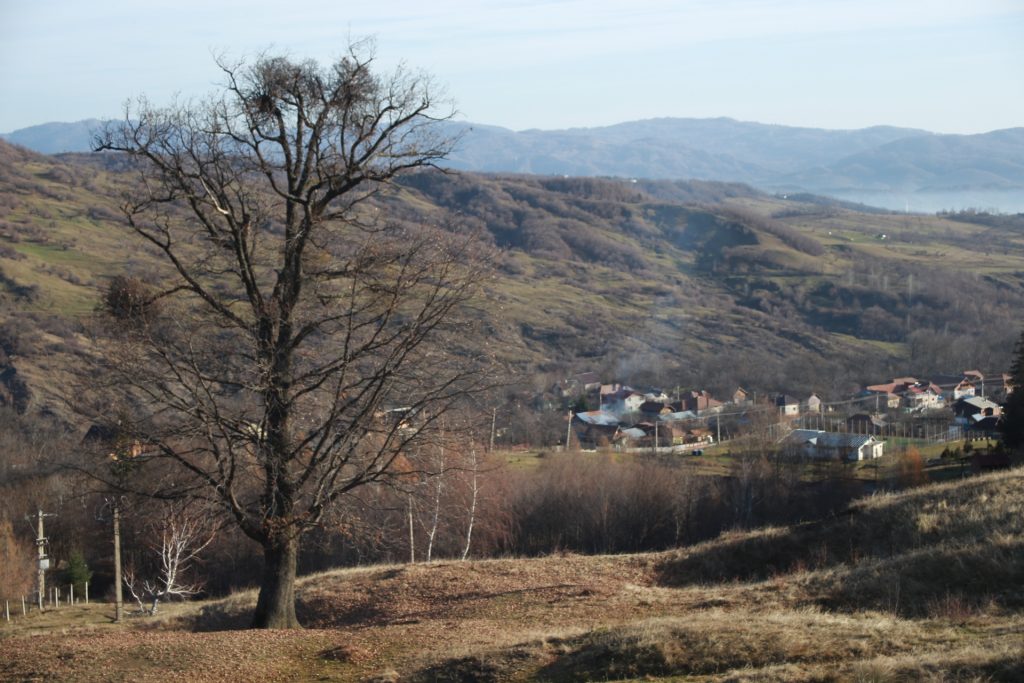
/Original title: Two foreigners living winter holidays in Romania/
We are Gertrudis and Andrea, volunteers of the association ‘’Curba De Cultură’’ here in Romania, precisely in the comune of Izvoarele (Prahova). For this year, we are involved in the project ‘’Discover Teisani’’: the initiative for promoting the commune and the citizens of Teișani utilizing audio-visual content, articles and many other materials. Nevertheless, today we are here to talk about something else.
This article is for all the curious readers who want to know about how it is celebrated in other countries on Christmas and New Year’s Eve. We will talk about what we saw, the experiences lived, the sensations and feelings we felt in our first fest as a foreign.
Everyone knows that the arrival of Christmas is often synonymous with the arrival of decorations: any type of ornament, lights and LEDs of all forms and colours, silent Santa Claus in the middle of climbing on every terrace … From our past experience we thought we had seen most of them. We were wrong, alas we had never been in Romania before. It was incredible, to say the least, how from one day to the next every house suddenly turned on, transforming the quiet country road into something more similar with how we imagine a street in Chinatown would be.
We could already feel in those days the Christmas spirit or, at least, we could feel that the preparatory phase was underway. Then, day after day, more and more people began to flock to the village. More shouting, more music, more partying. However, the exact moment in which we finally perceived to be in celebration was the awakening on that morning softened by a song, a canto. We discovered later that we heard the ‘’colindat’’, the Christmas carols. Basically that tradition consists of a group of people playing instruments and singing songs goes from one house to another. Originally, Christmas carols had a ritual function, namely that of wishing fertility and abundance. Today the common purpose of carols is to chase away the bad spirits of January and to wish a merry Christmas and the New Year’s Eve, creating a colourful and magical atmosphere.
Christmas was upon us and the village was fermenting. The air was now filled with the firecrackers, traditional music and the cracking of whips waved by the boys. The latter, as the Christmas carols, is a well-founded tradition: the boys wave a long whip in the air, producing thundering pops. The first few times we heard that sound we thought it was gunshots. Sound powerful enough, it is thought, to ward off evil spirits.
The unexpected climax of the holidays came on New Year’s Eve. We would never have thought that with the click of midnight the sky above Izvoarele would be coloured by a multitude of fireworks. For those intense minutes fireworks appeared from one side to the other, without respite. Even the house opposite ours decided to take part in that crackling dance. With the fall of the ashes left by the fireworks we went down the street, wearing masks, and taken by the euphoria, we met two kids who were also taken by the euphoria of meeting the strangers in the zone. It took a little, a few words but many gestures and we found ourselves immersed in a dance, led by the kids. In a circle, holding each other, we followed the music that never left us, always in the background. It was a worthy ending, a year’s farewell that let us in the positive mood we needed to continue planning the next explorations.
Of course, hiking in the surrounding areas was a must. Prahova is a great county for those who love nature. Just in Izvoarele, there is a quiet path going to Schiulesti and, once there, you can continue until the Crasna Monastery. Besides, it is worthwhile visiting the hills in Teisani. Winter provides a magical atmosphere once the snow arrives, but even before you can enjoy the diversity of colours that remains from the autumn. We also hiked in Sinaia and it was surprisingly calm. Although the tourism in Sinaia seems focused on skiing, the paths to arrive at the level 1450m were empty, and we had the feeling that all the immensity of nature was for us. For sure, you need to be prepared with energy and proper shoes for this kind of plan. However, you can also find more relaxed activities in Sinaia, such as visiting the Peleș Castle. There, you will be introduced in a mixture of styles (Turkish, Moorish, Venetian, Louis IV…) and the refined work in the wood that characterizes the building.
We cannot finish without mentioning that we had the chance to visit Bucharest during these holidays. It gave us a similar impression of a lively place with an interesting mix of styles in buildings. Not in the same way, but likewise attractive. With the amount of lights, the night was particularly alive in the old town. We had to be in the capital to arrive in Sinaia by train. It was lucky to get on an historical and beautiful international train heading to Vienna, ones with separate compartments. For sure, trains in Romania deserve another article in the future.
In the short time we were in Bucharest, we could visit a couple of bookstores. They were full of fancy decorations for Christmas. However, our eyes glanced directly at the shelves as they were looking for a treasure. These places, as well as the libraries, seem to safeguard in a very small space an enormous amount of knowledge about a country’s culture. Not only because of the content of the books themselves, but also because of the way the shelves are arranged, what subjects and authors they are interested in…
In conclusion, we are happy that this is only the beginning of our journey. Through ‘’Discovering Teisani’’ we are in the perfect place to satisfy our inner curiosity, which is expecting to appreciate all the wealth of this country.
